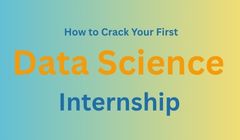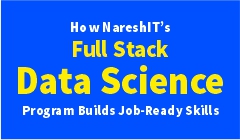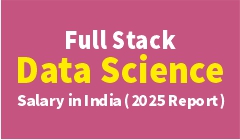
A comprehensive, beginner-friendly guide to help you move from novice to intern-ready in data science with real actions you can take now.
Landing your first Data Science internship can feel overwhelming. You may be wondering: “I have little experience how can I compete? What exactly do companies expect?” The truth is that internships are designed for learners. Companies hire for potential, curiosity, and basic technical foundations not for mastery.
This blog explains everything you need to know: the role of a data science intern, key skills, portfolio tips, application strategy, interview prep, and internship success habits.
What You’ll Typically Do:
Clean, merge, and prepare messy real-world datasets.
Perform exploratory data analysis (EDA) and generate insights.
Build or test simple models like regression and classification.
Create visualizations or dashboards to present findings.
Assist with data pipelines and documentation.
Learn from full-time data scientists and contribute to business problems.
Why It Matters:
Offers real-world experience with business data.
Builds portfolio projects for future job applications.
Opens doors to full-time roles through conversion offers.
What Companies Want:
Technical skills in Python, SQL, and statistics.
Problem-solving and curiosity about data.
Clear communication and teamwork.
Python: pandas, numpy, matplotlib, seaborn.
SQL: joins, aggregations, filtering, and window functions.
Statistics: distributions, confidence intervals, hypothesis testing.
Machine Learning Basics: regression, classification, metrics (accuracy, precision, recall).
Data Cleaning & EDA: handling missing data, outliers, and summarizing patterns.
Git/GitHub for version control and showcasing projects.
Tableau or Power BI for visualization.
Simple API or deployment basics for differentiation.
Clear communication and storytelling.
Adaptability and curiosity.
Collaboration and openness to feedback.
Sample Learning Roadmap:
Weeks 1–3: Python and pandas + SQL fundamentals.
Weeks 4–6: Statistics and EDA mini-project.
Weeks 7–10: Build and document one end-to-end project.
Weeks 11–14: Clean up GitHub, prepare resume, and start applying.
Why It Matters:
A strong portfolio is proof of capability. It tells recruiters you can apply theory to real data.
Project Tips:
Choose realistic, manageable datasets.
Focus on end-to-end execution data to results.
Add clear README documentation.
Prefer one solid project over many incomplete ones.
Example Projects:
Lead Scoring for Enrolments: predicting which leads convert using logistic regression.
Customer Segmentation: clustering and visualization for marketing insights.
GitHub Checklist:
Organized folders (data/, notebooks/, src/).
One-paragraph README explaining goal, approach, and results.
Screenshot or key metrics summary.
Link your GitHub profile in your resume.
For detailed guidance, refer to Naresh i Technologies’ Full Stack Data Science Program, which emphasizes end-to-end project development and real-world deployment skills.
Where to Look:
LinkedIn, Indeed, and Internshala (India-based internship listings).
University career portals and placement cells.
Company websites, especially tech and analytics firms.
Networking via LinkedIn and alumni connections.
Application Tips:
Tailor each resume to match the role.
Write concise, personalized cover messages.
Keep a simple tracker to manage applications.
Start applying once you have one solid project.
When to Apply:
Begin 3–6 months before internship season.
Don’t wait for perfection start early and iterate.
Explore Naresh i Technologies Career Support Programs to learn structured resume, LinkedIn, and interview optimization techniques designed for data science aspirants.
Technical Prep:
Brush Python, SQL, and statistics fundamentals.
Review your project: problem, approach, results, and challenges.
Learn to discuss trade-offs and decision logic.
Behavioral Prep:
Be ready for “Tell me about yourself” and “Why data science?”
Explain what excites you about solving data problems.
Practice confident, structured communication.
Common Questions:
“How would you predict which leads will convert?”
“Write an SQL query to find average sales per customer.”
“Why can a high model accuracy still fail in production?”
Mock interviews and portfolio walkthroughs are vital record yourself to review clarity and confidence.
Onboarding:
Understand project goals and deliverables.
Keep weekly learning notes.
During Internship:
Ask questions, volunteer for real tasks, and show curiosity.
Document every step your notes become future portfolio entries.
Present insights clearly and seek feedback.
After Internship:
Summarize contributions: “Built churn model, reduced manual calls by 20%.”
Add project to GitHub (if allowed).
Request a letter of recommendation.
Waiting too long to start applying.
Submitting resumes without project links.
Ignoring communication and presentation skills.
Applying to irrelevant roles or copying generic applications.
Not documenting your code or analysis.
| Week | Focus |
|---|---|
| 1–2 | Learn Python and pandas; explore small datasets. |
| 3–4 | SQL fundamentals + mini data aggregation project. |
| 5–6 | Statistics + EDA project (clean, analyze, visualize). |
| 7–8 | Build classification/regression model; evaluate results. |
| 9–10 | Clean up GitHub; document project; apply to 10–20 companies. |
| 11–12 | Practice interviews; finalize applications; follow up. |
Resume Bullet:
Data Science Intern Candidate – Python, SQL, GitHub | Built a lead conversion model analyzing device and behavior data; cleaned 50k records, achieved 0.82 accuracy, and documented code on GitHub: github.com/your-name/lead-score
Portfolio Summary:
Lead Scoring for Training Enrolments: cleaned and processed 50k lead records, engineered behavioral features, built logistic regression and random forest models, and achieved a 3× higher conversion rate in top 10% leads.
Q1. Can I get a data science internship with no experience?
Ans: Yes. Many companies look for potential and foundational skills in Python, SQL, and statistics.
Q2. How much preparation time is needed?
Ans: Around 8–12 hours per week for 3–4 months is realistic for building projects and applying.
Q3. Do I need deep learning knowledge?
Ans: Not initially. Focus on EDA, modeling, and basic ML these are most relevant for internships.
Q4. What if I’m from a non-CS background?
Ans: You can succeed by emphasizing transferable analytical skills and practical data projects.
Q5. How many applications should I send?
Ans: At least 30–50 well-tailored applications across different companies.
Q6. Where can I find data science internships in India?
Ans: Check Internshala for India-based internships and LinkedIn for global listings.
Q7. How important is GitHub?
Ans: Essential it’s your public portfolio. Keep it organized and professional.
Q8. What is the expected stipend?
Ans: Ranges widely from unpaid to ₹5,000–₹20,000 per month depending on company type.
Q9. How can I turn the internship into a job offer?
Ans: Be proactive, deliver results, communicate clearly, and seek feedback regularly.
Q10. What if I face rejections?
Ans: Refine your resume, polish GitHub, and continue applying. Persistence is key.
Your first data science internship is your bridge from learning to real-world problem solving. You don’t need to be perfect just consistent, curious, and project-oriented.
Start today. Build one complete project, polish your portfolio, and apply widely. With each attempt, you’ll grow stronger and more confident.
The opportunities are closer than you think especially if you prepare smartly with structured guidance from Naresh i Technologies Data Science with AI Training Programs designed for students and fresh graduates.

A practical, end-to-end blueprint from the first dataset to a deployed model designed for real jobs in India’s 2025 market.
Breaking into data science isn’t about memorizing buzzwords or copying notebook code. Employers want outcomes: can you take a messy business problem, clean the data, build a reliable model, deploy it, monitor it, and explain it in simple terms?
Naresh i Technologies’ Full Stack Data Science AI Program is built exactly for that. It’s not just another course it’s a production-style apprenticeship. You’ll learn by doing, build deployable models, and graduate with a portfolio recruiters will actually open.
Below is a clear walkthrough of how this program develops job-ready skills from foundations to MLOps along with assessments, tools, and placement support that lead to real career outcomes.
Most data science courses stop at model training. Ours goes end-to-end:
Business Framing – Convert vague requirements into measurable goals.
Data Acquisition – Learn SQL, APIs, and data privacy principles.
Data Cleaning & EDA – Pandas, profiling, and data storytelling.
Feature Engineering – Transform raw data into predictive insights.
Modeling – Classical ML (regression, classification, trees, boosting).
Evaluation – Cross-validation and cost-aware metrics.
MLOps & Deployment – Pipelines, versioning, FastAPI, Docker, CI/CD, and cloud.
Monitoring – Track drift, build alerts, and retrain models.
Communication – Create stakeholder decks, resumes, and GitHub portfolios.
“Full stack” means moving from notebook experiments to production-ready analytics that businesses can trust.
Fresh graduates (B.Tech/B.Sc/MCA) seeking practical, guided training.
Career switchers from testing, support, or non-CS fields.
Working professionals in analytics or BI who want MLOps exposure.
Target Roles After Graduation:
Data Analyst → Junior Data Scientist
Machine Learning Engineer (entry-level)
Data Engineer (beginner)
BI Analyst or Analytics Consultant
Pandas, NumPy, Matplotlib, Plotly
SQL joins, window functions, and optimization
Data quality checks and schema validation
Sampling, variability, and A/B testing
Correlation, p-values, and confidence intervals
Regression, classification, and ensemble models
Handling imbalanced data with PR-AUC and thresholds
Encoding, text basics, date/time transformations
Build pipelines, containerize with Docker, deploy with FastAPI
Track experiments with MLflow and CI/CD automation
Detect drift, create retraining cadences, ensure ethical use
Resume and GitHub optimization
Storytelling for technical interviews
Phase 1: Python & SQL foundations + first EDA project
Phase 2: Model training and validation with real datasets
Phase 3: Feature engineering and explainability
Phase 4: Deployment using FastAPI and Docker
Phase 5 (Optional): BI dashboard and storytelling
Each phase includes deliverables like notebooks, dashboards, APIs, and documentation all part of your portfolio.
You’ll pick one domain (e.g., Marketing, FinTech, Retail, or EdTech) and build a complete pipeline:
Clean and analyze data
Train and evaluate models
Deploy an API
Containerize with Docker
Add monitoring documentation
Create a GitHub-ready README and executive summary
This project becomes your job-ready showcase of full-stack capability.
Weekly quizzes on Python, SQL, and ML concepts
Hands-on labs and code reviews
Milestone demos with trainer feedback
Capstone viva: defend your modeling and deployment approach
Portfolio audits to ensure recruiter readiness
Clean GitHub structure (data, notebooks, models, reports)
README storytelling for recruiters
Resume rewrite with quantified impact
Mock interviews technical, case-based, and HR rounds
You’ll graduate ready to demonstrate your skills with confidence.
Production-first learning: You’ll build working models, not just theories.
Business-driven metrics: Learn PR-AUC and threshold trade-offs for real Indian use cases.
Ethical AI focus: PII handling, consent, and fairness tracking.
Placement-backed outcomes: Mock interviews, role-matching, and mentoring sessions.
Week 1–2: Python, SQL, and EDA
Week 3–4: Statistics and model training
Week 5–6: Feature engineering and evaluation
Week 7–8: Deployment with FastAPI and Docker
Week 9–10: Monitoring and final capstone project
Optional Weeks 11–12 cover BI dashboards and storytelling.
A deployable ML model and API endpoint
A polished GitHub portfolio with 3–5 projects
An executive summary and project walkthrough
Resume with measurable outcomes
Placement support and personal job plan
Employers will see not imagine your capability.
Q1. I’m not from a computer science background. Can I join?
Ans: Yes. The course starts from first principles and builds up gradually.
Q2. Will I work on real data?
Ans: Absolutely. You’ll handle messy datasets, outliers, and real business problems.
Q3. What tools will I use?
Ans: Python, scikit-learn, FastAPI, Docker, SQL, and cloud tools like AWS/GCP.
Q4. Is placement support provided?
Ans: Yes. You’ll receive interview preparation, mock sessions, and personalized job guidance.
Q5. Can I do this course while working?
Ans: Yes. It’s designed for 10–12 hours of weekly commitment with flexible pacing.
Morning: Watch a 20-minute concept video
Afternoon: Practice a notebook or SQL problem
Evening: Attend a live trainer walkthrough
Wrap-up: Commit your project to GitHub
Each day builds momentum toward a deployable project.
If you’re ready to build a practical, job-ready portfolio and launch your data science career, it’s time to take the next step.
Book your Free Consultation with Naresh i Technologies and see how our mentors can guide your transition from beginner to full-stack data professional.
Explore our Full Stack Data Science with AI Training Program built for India’s evolving 2025 job market, with mentorship, projects, and placement support included.
The Indian job market rewards those who turn data into decisions. With NareshIT’s Full Stack Data Science Program, you won’t just learn data science you’ll do it. From raw data to deployed models, from notebooks to APIs, you’ll graduate with results that employers can see, run, and hire for.

As organizations increasingly seek professionals who can handle the full data pipeline from ingestion and cleaning to modeling, deployment, and monitoring the Full Stack Data Scientist role has become one of the most valuable in India’s tech landscape.
This report explores what you can expect to earn in 2025 as a Full Stack Data Scientist, which factors drive pay differences, and how you can strategically upskill to command higher compensation. Since Naresh i Technologies specializes in training and career development, we’ll also outline how learners can plan for better salary outcomes through end-to-end data science learning.
According to Glassdoor, the average salary for a Full Stack Data Scientist in India is around ₹11.25 LPA.
For a general “Data Scientist,” the average salary is approximately ₹16.5 LPA.
Entry-level professionals typically earn ₹6–8 LPA, mid-level ₹12–15 LPA, and senior experts ₹20 LPA or more.
Related “Full Stack Data Engineer” roles average ₹13.4 LPA in India.
Top 10% Full Stack Data Scientists earn up to ₹32 LPA.
Senior professionals with 10+ years of experience, especially in product or AI-driven firms, can exceed ₹40 LPA or more.
Bengaluru leads with average pay near ₹18.5 LPA.
Delhi NCR follows at ₹14 LPA.
Tier-2 cities offer lower pay, balancing cost of living and market size.
A Full Stack Data Scientist can manage the complete workflow:
Data ingestion from APIs and databases
Cleaning and feature engineering
EDA and visualization
Model building and evaluation
Deployment (APIs, cloud, pipelines)
Post-deployment monitoring for drift
Because of this end-to-end capability, organizations pay a premium for such professionals valuing their ability to deliver production-ready, business-impactful solutions.
Key factors influencing pay include:
Experience Level: Entry (<2 yrs), mid (3–5 yrs), senior (5+ yrs)
Industry: Product, fintech, or analytics firms pay more than generic IT services
Skill Stack: Cloud, MLOps, and deployment expertise command higher value
Location: Bengaluru, Hyderabad, and Mumbai lead in pay scales
Company Type: Funded startups and global firms pay higher than service providers
Education/Certification: Domain-specific or advanced degrees can add leverage
| Experience Level | Typical Salary Range | Key Highlights |
|---|---|---|
| Fresher (0–2 yrs) | ₹6–10 LPA | Python, SQL, EDA basics |
| Junior (2–4 yrs) | ₹10–15 LPA | Model building, minor deployment |
| Mid-Level (4–7 yrs) | ₹15–25 LPA | End-to-end projects, small team handling |
| Senior (7–10 yrs) | ₹25–40 LPA+ | Leading teams, domain expertise |
| Principal / Lead | ₹40–60 LPA+ | Strategic leadership, MLOps & cloud mastery |
Deployment & MLOps: Turning notebooks into production-grade models.
Cloud Platforms: AWS, Azure, or GCP proficiency.
Big Data Tools: Spark, Kafka, Hadoop.
Domain Knowledge: FinTech, HealthTech, Retail, etc.
Leadership & Communication: Translating model results into business impact.
At Naresh i Technologies, the Full Stack Data Science wth AI Training with Placement Support includes modules covering:
Data engineering and ingestion
Model building and tuning
Cloud deployment and monitoring
Real-time capstone projects simulating the entire workflow
These components directly align with the skills employers reward with higher salaries.
Quantify project impact (e.g., “Improved accuracy by 20%” or “Deployed model serving 10K+ requests/day”).
Research city-wise pay benchmarks.
Negotiate total compensation, not just base salary consider bonuses and ESOPs.
Ask about growth trajectory and pay progression.
Bengaluru: ₹18–20 LPA average (product and AI firms dominate)
Hyderabad/Pune/Chennai: ₹12–15 LPA
Tier-2 cities: ₹7–10 LPA
Product / Startup Firms: Higher pay + ESOPs.
Consulting / Analytics Services: Steady but slightly lower pay.
Traditional IT Services: Modest salaries, broader exposure.
Year 0–2: Build core technical foundation; target ₹6–10 LPA.
Year 2–4: Deploy small models, demonstrate ownership; target ₹10–15 LPA.
Year 4–7: Master MLOps, lead small teams; target ₹15–25 LPA.
Year 7+: Domain specialization, strategic projects; target ₹25–40 LPA+.
For learners, this means showing portfolio projects with real deployments not just analysis notebooks.
Median salaries for data science continue to rise in India.
“Full stack” skills are in short supply, driving premium pay.
Cloud + MLOps integration is becoming essential.
Demand will remain strong across product and AI-driven companies.
| Myth | Reality |
|---|---|
| “Just knowing ML ensures ₹20 LPA fresh.” | Without deployment & domain exposure, freshers average ₹6–10 LPA. |
| “I must learn everything.” | Focus on end-to-end competence first. |
| “Location doesn’t matter.” | Major metros still pay 30–50% more. |
| “Every job change doubles salary.” | Typical uplift is 25–40% with full-stack skill upgrades. |
Q1. What is a fresher’s salary in 2025?
Ans: ₹6–10 LPA on average, depending on project exposure and deployment experience.
Q2. What about 3–5 years of experience?
Ans: ₹12–18 LPA, potentially more in product firms.
Q3. Senior roles (7+ years)?
Ans: ₹25–40 LPA or more, especially with leadership and cloud skills.
Q4. Does full stack data science pay more than regular data science?
Ans: Yes- due to deployment, DevOps, and cloud integration responsibilities.
Q5. Which cities pay best?
Ans: Bengaluru, Hyderabad, and Mumbai lead.
Q6. Do certifications help?
Ans: They validate skills, but practical projects matter most.
Q7. Are ESOPs and bonuses common?
Ans: Yes, especially in product and funded startups.
Q8. How should I negotiate as a fresher?
Ans: Highlight your end-to-end project skills, research benchmarks, and show deploy-ready work.
Build one end-to-end full stack project (ingestion → cleaning → modeling → API deployment → monitoring).
Publish a learner story post: “How I reached ₹15 LPA in 3 years as a Full Stack Data Scientist.”
Offer workshops on salary negotiation and portfolio building.
Track alumni outcomes to demonstrate real market value.
Encourage focus on cloud and deployment skills for long-term salary growth.
In 2025, the Full Stack Data Scientist role continues to be one of the most lucrative in India’s technology sector. Professionals who master the full lifecycle from data to deployment can expect faster growth, better compensation, and stronger career mobility.
For Naresh i Technologies, this means helping learners build job-ready full stack data science skills through hands-on projects, real-world tools, and placement-focused mentorship.
Start Your Full Stack Data Science Journey Today
Explore our Data Science with MLOps Training Program and become industry-ready for high-paying roles in 2025.